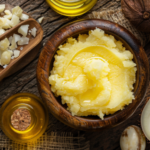Across Africa’s diverse landscapes from the sunbaked Kalahari to the lush savannas of West Africa women and communities have long relied on plant oils to nourish, protect, and care for the skin. Extracted from resilient seeds and fruits, these oils are more than cosmetic ingredients; they represent cultural heritage, ecological adaptation, and community livelihoods.
Cold‑pressed, nutrient‑rich African oils can help soothe dryness, support the skin barrier, and add natural radiance when used appropriately. These benefits arise from measurable compounds in the oils: essential fatty acids that replenish lipids, oil-soluble antioxidants such as tocopherols that slow oxidation, and minor bioactive constituents that may influence skin feel and tone. Expect texture differences: linoleic-dominant oils (light, fast-absorbing) suit oilier or blemish-prone skin, while oleic-rich or long-chain fatty acid oils feel richer and work well for dry, mature, or weathered skin.
Evidence comes in three tiers:
- Long traditions of use and ethnobotanical documentation.
- Laboratory analyses mapping fatty-acid profiles, antioxidant content, and markers such as peroxide and free fatty acid values.
- A smaller set of human clinical studies testing specific topical effects.
Where clinical data are limited, we flag this clearly and avoid medical or therapeutic language. In practice, most recommendations in this series combine ingredient science, traditional knowledge, and responsible formulator guidance.
Practical expectations: look for cold-pressed, unrefined oils in dark glass bottles with a listed “best by” date; keep blends simple; patch-test new oils for 24–48 hours; and store them below 25 °C, away from sunlight, to preserve quality.
What this series will teach you
Nutrient facts
- Clear, reader-friendly breakdowns of key fatty acids, tocopherol levels, and what those numbers mean for skin and hair.
- Each oil entry includes a short “ingredient snapshot” card showing typical fatty-acid ranges, comedogenicity notes, and evidence level (traditional use / ingredient analysis / human trial).
Cultural history and sourcing
- Concise, respectful accounts of how communities harvest and use each oil.
- Example case studies from named regions or cooperatives when available.
- Processing methods (cold-press vs refined) explained to highlight how production shapes quality and value.
Safe home uses and sustainability tips
- Practical DIY recipes, dilution and essential-oil safety guidance, storage and shelf-life advice.
- Concrete sourcing pointers: what to look for on labels, questions to ask brands, and red flags for greenwashing.
- Community impact indicators: cooperative partnerships, fair-pay practices, replanting commitments, and published Certificates of Analysis — so you can vote with your wallet.
Each post concludes with a short “Who benefits?” box mapping the oil to skin types, hair needs, and sustainable-sourcing wins, for quick reader reference.
How we checked this series
- Nutrient and quality data: laboratory fatty-acid analyses, published Certificates of Analysis (COAs) where available, and peer-reviewed or reputable analytical reports.
- Cultural and traditional use notes: ethnobotanical literature, field reports, and interviews with cooperative leaders and harvesters; direct quotes or cooperative claims are noted with permission.
- Sustainability guidance: NGO reports, cooperative case studies, and market audits; gaps in transparency are flagged and explained, including why certain certifications or documents matter.
Related Posts
-
Argan & Moringa oils: African traditions that transform
Africa’s beauty secrets are as diverse as its landscapes, and two oils—argan oil (Argania spinosa)…
-
African beauty oils: Marula & Baobab – Skincare secrets from the continent
For generations, communities across Africa have turned to native trees not only for food and…
-
Baobab & Marula oils: Ancient african beauty secrets with modern benefits
Across Africa’s landscapes stand two iconic trees with deep cultural and ecological significance: the baobab…


